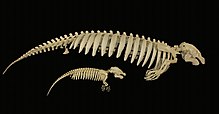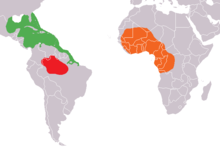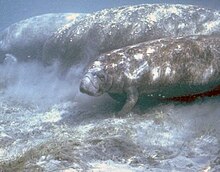
Taxonomy
Manatees comprise three of the four living species in the order Sirenia. The fourth is the Eastern Hemisphere's dugong. The Sirenia are thought to have evolved from four-legged land mammals over 60 million years ago, with the closest living relatives being the Proboscidea (elephants) and Hyracoidea (hyraxes).[3]The Amazonian's hair color is brownish gray, and they have thick wrinkled skin often with coarse hair, or "whiskers". Photos are rare; although very little is known about this species, scientists think they are similar to West Indian manatees.
Description

Skull of a West Indian manatee on display at The Museum of Osteology, Oklahoma City, Oklahoma.
Manatees are unusual amongst mammals in possessing just six cervical vertebrae,[8] which may be due to mutations in the homeotic genes.[9] All other mammals have seven cervical vertebrae,[10] other than the two-toed and three-toed sloths.
Like horses, they have a simple stomach, but a large cecum, in which they can digest tough plant matter. In general, their intestines have a typical length of about 45 meters, which is unusually long for animals of their size.[11] Manatees produce enormous amounts of gas, which contributes to their barrel-shape, to aid in the digestion of their food.[12]
Manatees are the only animal known to have a vascularized cornea.[13]
Behavior
Apart from mothers with their young, or males following a receptive female, manatees are generally solitary animals.[6] Manatees spend approximately 50% of the day sleeping submerged, surfacing for air regularly at intervals of less than 20 minutes. The remainder of the time is mostly spent grazing in shallow waters at depths of 1–2 metres (3.3–6.6 ft). The Florida subspecies (T. m. latirostris) has been known to live up to 60 years.Locomotion
Generally, manatees swim at about 5 to 8 kilometres per hour (3 to 5 mph). However, they have been known to swim at up to 30 kilometres per hour (20 mph) in short bursts.Intelligence and learning
Manatees are capable of understanding discrimination tasks and show signs of complex associative learning. They also have good long-term memory.[14] They demonstrate discrimination and task-learning abilities similar to dolphins and pinnipeds in acoustic and visual studies.[15]Reproduction
Manatees typically breed once every two years; generally only a single calf is born. Gestation lasts about 12 months and a further 12 to 18 months to wean the calf.[6]Communication
Manatees emit a wide range of sounds used in communication, especially between cows and their calves. Adults communicate to maintain contact and during sexual and play behaviors. Taste and smell, in addition to sight, sound, and touch, may also be forms of communication.[citation needed]Diet
Manatees are herbivores and eat over 60 different freshwater ( e.g. floating hyacinth, pickerel weed, alligator weed, water lettuce, hydrilla, water celery, musk grass, mangrove leaves) and saltwater plants (e.g. sea grasses, shoal grass, manatee grass, turtle grass, widgeon grass, sea clover, and marine algae). Using their divided upper lip, an adult manatee will commonly eat up to 10%-15% of their body weight (about 50 kg) per day. Consuming such an amount requires the manatee to graze for up to seven hours a day.[16] Manatees have been known to eat small amounts of fish from nets.[17]Feeding behavior
Manatees use their flippers to "walk" along the bottom whilst they dig for plants and roots in the substrate. When plants are detected, the flippers are used to scoop the vegetation toward the manatee's lips. The manatee has prehensile lips; the upper lip pad is split into left and right sides which can move independently. The lips use seven muscles to manipulate and tear at plants. Manatees use their lips and front flippers to move the plants into the mouth. The manatee does not have front teeth, however, behind the lips, on the roof of the mouth, there are dense, ridged pads. These horny ridges, and the manatee's lower jaw, tear through ingested plant material.[16]Dentition
Manatees have four rows of teeth. There are 6 to 8 high-crowned, open-rooted molars located along each side of the upper and lower jaw giving a total of 24 to 32 flat, rough-textured teeth. Eating gritty vegetation abrades the teeth, particularly the enamel crown, however, research indicates that the enamel structure in manatee molars is weak. To compensate for this, manatee teeth are continually replaced. When anterior molars wear down, they are shed. Posterior molars erupt at the back of the row and slowly move forward to replace these like enamel crowns on a conveyor belt. This process continues throughout the manatee's lifetime. The rate at which the teeth migrate forward depends on how quickly the anterior teeth abrade. Some studies indicate that the rate is about 1 cm/month although other studies indicate 0.1 cm/month.[16] This process of teeth being continually replaced is known as polyphyodonty and amongst other mammals, only occurs in elephants and kangaroos.Ecology
Range and habitat
West Indian manatees prefer warmer temperatures and are known to congregate in shallow waters. They frequently migrate through brackish water estuaries to freshwater springs. They cannot survive below 15 °C (60 °F). Their natural source for warmth during winter is warm, spring-fed rivers.
West Indian
The coast of the state of Georgia is usually the northernmost range of the West Indian manatees because their low metabolic rate does not protect them in cold water. Prolonged exposure to water temperatures below 68 °F (20 °C) can bring about "cold stress syndrome" and death.[19]Florida manatees can move freely between salinity extremes.
Manatees have been seen as far north as Cape Cod, and in 2006, one was seen in New York City and Rhode Island's Narragansett Bay, as cited in The Boston Globe. According to Memphis, Tennessee's The Commercial Appeal newspaper, one manatee was spotted in the Wolf River harbor near the Mississippi River in downtown Memphis on October 23, 2006, though it was later found dead 10 miles downriver in McKellar Lake.[citation needed]
The West Indian manatee migrates into Florida rivers, such as the Crystal, the Homosassa, and the Chassahowitzka Rivers. The headsprings of these rivers maintain a 22 °C (72 °F) temperature all year. During November to March, about 400 West Indian manatees (according to the National Wildlife Refuge) congregate in the rivers in Citrus County, Florida.[citation needed]
During winter, manatees often congregate near the warm-water outflows of power plants along the coast of Florida instead of migrating south as they once did. Some conservations are concerned these manatees have become too reliant on these artificially warmed areas.[20] The U.S. Fish and Wildlife Service is trying to find a new way to heat the water for manatees that are dependent on plants that have closed. The main water treatment plant in Guyana has four manatees that keep storage canals clear of weeds; there are also some in the ponds of the National Park in Georgetown, Guyana.
Studies suggest Florida manatees must have some access to fresh water for proper regulation of water and salts within their bodies.
Accurate population estimates of the Florida manatee (T. manatus) are difficult. They have been called scientifically weak[21] due to widely varying counts from year to year, some areas showing increases, others decreases and little strong evidence of increases except in two areas. Manatee counts are highly variable without an accurate way to estimate numbers: In Florida in 1996, a winter survey found 2,639 manatees, in 1997, a January survey found 2,229, and a February survey found 1,706.[15] A statewide synoptic survey in January 2010 found 5,067 manatees living in Florida, which was a new record count.[22]
Population viability studies conducted in 1997 found that decreasing adult survival and eventual extinction is a probable future outcome for Florida manatees, without additional protection.[23]
Fossil remains of Florida manatee ancestors date back about 45 million years.[citation needed]
Amazonian
The freshwater Amazonian manatee (T. inunguis) inhabits the Amazon River and its tributaries, and never ventures into salt water.West African
They are found in coastal marine and estuarine habitats, and in freshwater river systems along the west coast of Africa from the Senegal River south to the Kwanza River in Angola. They live as far upriver on the Niger River as Gao, Mali.[citation needed]Predation
Overall, predation does not present a significant threat to the survival of any manatee species.Relation to humans
Main article: Manatee Conservation Status

Young manatees can be curious; this individual is inspecting a kayak
Threats
The main causes of death for manatees are human-related issues, such as habitat destruction and human objects. Natural causes of death include adverse temperatures and disease.Ship strikes
Their slow-moving, curious nature, coupled with dense coastal development, has led to many violent collisions with propeller-driven boats and ships, leading frequently to maiming, disfigurement, and even death. As a result, a large proportion of manatees exhibit spiral cutting propeller scars on their backs, usually caused by larger vessels that do not have skegs in front of the propellers like the smaller outboard and inboard-outboard recreational boats have. They are now even identified by humans based on their scar patterns. Many manatees have been cut in half by large vessels like ships and tug boats, even in the highly populated lower St. Johns River's narrow channels. Some are concerned that the current situation is inhumane, with upwards of 50 scars and disfigurements from vessel strikes on a single manatee.[24] Often, the cuts lead to infections, which can prove fatal. Internal injuries stemming from being trapped between hulls and docks and impacts have also been fatal.Manatees hear on a higher frequency than would be expected for such large marine mammals. Many large boats emit very low frequencies, which confuse the manatee and explain their lack of awareness around boats. The Lloyd's mirror effect results in low frequency propeller sounds not being discernible near the surface, where most accidents occur. Research indicates that when a boat has a higher frequency the manatees rapidly swim away from danger.[25]
In 2003, a population model was released by the United States Geological Survey that predicted an extremely grave situation confronting the manatee in both the Southwest and Atlantic regions where the vast majority of manatees are found. It states,
- "In the absence of any new management action, that is, if boat mortality rates continue to increase at the rates observed since 1992, the situation in the Atlantic and Southwest regions is dire, with no chance of meeting recovery criteria within 100 years."[26]
- "Hurricanes, cold stress, red tide poisoning and a variety of other maladies threaten manatees, but by far their greatest danger is from watercraft strikes, which account for about a quarter of Florida manatee deaths," said study curator John Jett.[27]
- "The severity of mutilations for some of these individuals can be astounding – including long term survivors with completely severed tails, major tail mutilations, and multiple disfiguring dorsal lacerations. These injuries not only cause gruesome wounds, but may also impact population processes by reducing calf production (and survival) in wounded females – observations also speak to the likely pain and suffering endured".[15] In an example, they cited one case study of a small calf "with a severe dorsal mutilation trailing a decomposing piece of dermis and muscle as it continued to accompany and nurse from its mother...by age 2 its dorsum was grossly deformed and included a large protruding rib fragment visible."[15]
- "the overwhelming documentation of gruesome wounding of manatees leaves no room for denial. Minimization of this injury is explicit in the Recovery Plan, several state statutes, and federal laws, and implicit in our society's ethical and moral standards."[15]
Red tide
Another cause of manatee deaths is the red tide, a term used for the proliferation, or "blooms", of the microscopic marine algae of the species Karenia brevis, a member of the dinoflagellates that produces brevetoxins that can have toxic effects on the central nervous systems of creatures in the area of the algae bloom.[30]In 1996, a red tide was responsible for 151 manatee deaths.[31] The epidemic began on March 5 and continued through April 28, wiping out approximately 15% of the known population of manatees along South Florida's western coast.[32] In 1982, another outbreak resulted in 37 deaths,[33] and in 2005, 44 more deaths were attributed to the blooms.
Additional threats
Manatees occasionally ingest fishing gear (hooks, metal weights, etc.) while feeding. These foreign materials do not appear to harm manatees, except for monofilament line or string, which can clog a manatee's digestive system and slowly kill it.Manatees can also be crushed in water control structures (navigation locks, floodgates, etc.), drown in pipes and culverts, and are occasionally killed by entanglement in fishing gear, primarily crab pot float lines.
While humans are allowed to swim with manatees in one area of Florida,[34] there have been numerous charges of people harassing and disturbing the manatees.[35]
The African manatee's only significant threats are due to poaching, habitat loss, and other environmental impacts.[citation needed] They occasionally get stranded as the river dries up at the end of rainy season.
Conservation
All three species of manatee are listed by the World Conservation Union as vulnerable to extinction.It is illegal under federal and Florida law to injure or harm a manatee. They are classified as "endangered" by both the state and the federal governments.
The MV Freedom Star and MV Liberty Star, ships used by NASA to tow space shuttle solid rocket boosters back to Kennedy Space Center, are propelled only by water jets to protect the endangered manatee population that inhabits regions of the Banana River where the ships are based.
Brazil outlawed hunting in 1973 in an effort to preserve the species. Deaths by boat strikes are still common.
Hunting
Manatees were traditionally hunted by indigenous Caribbean people. When Christopher Columbus arrived in the region, hunting was already an established trade, although this is less common today.[36]The primary hunting method was for the hunter to approach in a dugout canoe, offering bait to attract it close enough to temporarily stun it with a blow near the head from an oar-like pole. Many times the creature would flip over, leaving it vulnerable to further attacks.
From manatee hides, Native Americans made war shields, canoes, and shoes, though manatees were predominantly hunted for their abundant meat.
Later, manatees were hunted for their bones, which were used to make "special potions". Until the 1800s, museums paid as much as $100 for bones or hides. Though hunting was banned in 1893, poaching continues today.
Captivity
The oldest manatee in captivity is Snooty, at the South Florida Museum's Parker Manatee Aquarium in Bradenton, Florida. Born at the Miami Aquarium and Tackle Company on July 21, 1948 (age 65), Snooty was one of the first recorded captive manatee births. Raised entirely in captivity, Snooty will never be released into the wild. So he is the only manatee at the Aquarium, and one of a select few captive manatees in the United States, that is allowed to interact with human handlers. This makes him uniquely suitable to manatee research and education.[37]Manatees can also be viewed in a number of European zoos, such as the Tierpark in Berlin, the Nuremberg Zoo, in ZooParc de Beauval in France and in the Aquarium of Genoa in Italy. The River Safari at Singapore features seven of them.[38] They are also included in the plans for a new National Wildlife Conservation Park in Bristol, England, whose first exhibit is due to open in summer 2013[39] with the manatees as an addition as early as 2015.[40]








No comments:
Post a Comment
Note: Only a member of this blog may post a comment.